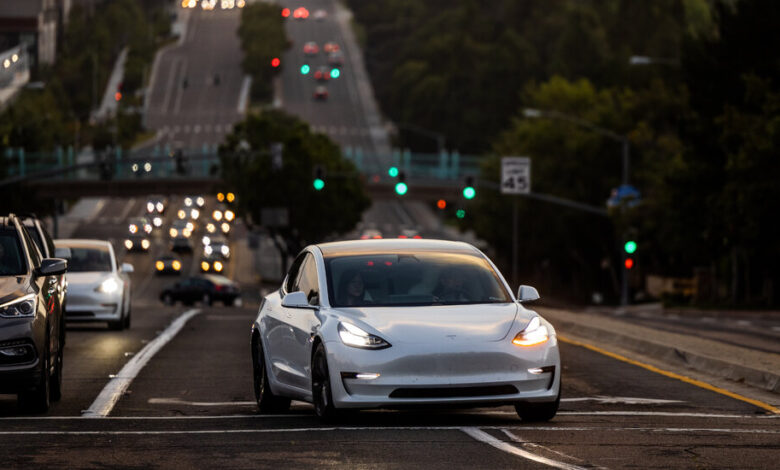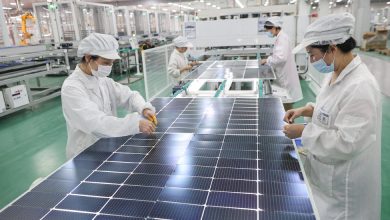Here Are the Challenges Ahead for California’s Ban on Gas Cars

California has laid out an audacious goal: In 13 years, it should no longer be possible to buy a new car anywhere in the state that runs purely on gasoline.
Yet it remains to be seen whether California can turn that vision into a reality. The state’s plan to ban sales of new internal-combustion engine vehicles by 2035, approved by regulators on Thursday, sets strict limits on what automakers can and can’t sell. Failure to meet those targets carries the threat of stiff penalties.
But whether the rule works in practice will depend on whether consumers embrace electric cars and how rapidly automakers can ramp up production of cleaner vehicles, which could prove challenging. There is also the widespread expectation of legal challenges that could hinder the policy, and some experts said those challenges might have a decent chance of success because of the unusual process by which California is allowed to set some of its own pollution laws.
“It’s a hell of a way to set transportation policy,” said Scott Segal, a partner at Bracewell LLP, a law firm that represents energy industry clients. “This is obviously a very tight schedule that California envisions as a standard for the sale of new automobiles,” he said. “It has pretty significant consequences for consumers and the supply chain.”
In addition, more than a dozen other states — which, together with California, represent roughly one-third of the American auto market — typically adopt California’s stricter standards on car pollution. Many have signaled that they will follow suit on the new rule, and five are already actively preparing to do so. But the speed and sweep of those decisions could further complicate the rollout because scale matters: A larger market could push down prices for electric cars due manufacturing efficiencies. Or, it could force prices higher if it causes more production bottlenecks like those that are already plaguing the industry.
For years, governments around the world have tried more moderate measures to encourage sales of electric vehicles, which typically produce fewer planet-warming gases like carbon dioxide than traditional gasoline-powered models. China orders automakers to produce a certain fraction of zero-emissions vehicles in their fleets each year. Norway uses a combination of hefty financial incentives and taxes to steer consumers toward electric cars, which now make up 80 percent of new sales there.
California is taking a blunter approach. If automakers want to participate in America’s largest vehicle market, then 35 percent of the new passenger cars and light trucks they sell in 2026 will have to be electric vehicles or other emissions-free models, up from about 16 percent today.
Those targets rise to 68 percent in 2030, and 100 percent in 2035.
If automakers fail to comply, they will face a $20,000 fine for each new vehicle sold in violation of the targets. Since that amount far exceeds the profit margin of the typical passenger vehicle, it is unlikely that companies would choose to pay the penalty, experts said.
“California is good at enforcing its rules,” said Dan Becker, director of the Safe Climate Transport Campaign at the Center for Biological Diversity. “Companies at their peril violate those rules.”
Read More on Electric Vehicles
- Inflation Reduction Act: The law extends tax incentives in an effort to steer more U.S. consumers toward electric cars. But new rules complicate the qualification process.
- Plug-In Hybrids: After falling behind all-electric cars, U.S. sales of plug-in hybrids have been surging. The high cost of electric cars and gasoline have given them an opening.
- Car Crashes: Tesla and other automakers capture data from their vehicles to operate their products. Experts say the collected information could also improve road safety.
- A Frustrating Hassle: The electric vehicle revolution is nearly here, but its arrival is being slowed by a fundamental problem: The chargers where people refuel these cars are often broken.
But the rule can’t force California’s car shoppers to actually buy the new electric vehicles that automakers will now have to offer. And if consumers don’t follow along, that’s a much harder problem to address. Ultimately, experts said, the plan rests on faith that people will eagerly flock to battery-powered vehicles in the coming years just as, in the past, they rapidly adopted cellphones or microwave ovens.
The rule also does not affect the hundreds of thousands of used cars and light trucks sold in California each year, raising the possibility that some people could simply hold on to their older gasoline-powered vehicles for longer if they are reluctant to purchase electric models.
Mr. Becker said that was worrisome for the climate. “Many of the vehicles produced and sold after 2030 will still be on the road guzzling and polluting by 2050,” he said. Mr. Becker said his group and others have been pushing California regulators to move up the deadline of a total ban on the sale of gas-powered vehicles to 2030 and will continue to lobby for that change.
Officials at the California Air Resources Board, the agency overseeing the new rule, have said they reserve the right to amend the targets if the market doesn’t evolve in the way they hope. In a report in April, agency staffers wrote that “consumer challenges” could prove a significant hurdle, noting that many people are wary of the high costs of electric vehicles, the availability of charging and unfamiliarity with the technology.
Currently, the average electric vehicle sells for about $66,000, compared to $48,000 for the average internal combustion engine vehicle, according to Kelley Blue Book. And while many homeowners can install a charger in their garage, people who live in apartment buildings don’t always have that option. The state may need 1.9 million additional public chargers by 2035 to meet the new goals, researchers at the University of California, Davis, have estimated.
State officials say those challenges are surmountable, pointing to studies showing that electric vehicles can save money over time thanks to lower fuel and maintenance costs. They also estimate that the price of electric vehicles should become competitive with gasoline-powered models by 2030, if not sooner, as production ramps up and battery costs fall.
California’s new rule gives automakers extra credit toward meeting their sales quotas if they offer new electric models that cost less than $20,275 or sell discounted cars coming off lease. And the Inflation Reduction Act, signed into law recently by President Biden, offers up to $7,500 in tax breaks for zero-emissions vehicles made in North America, though many automakers have said they may struggle to qualify in the near term as they adjust supply chains.
Consumer demand appears to be rising fast. A recent survey from Consumer Reports found that 14 percent of Americans would “definitely” buy or lease an electric vehicle for their next purchase, up from 4 percent in 2020, while another 22 percent would “seriously consider” it. But the survey also found that 28 percent of Americans would not consider making the switch.
Gil Tal, a transportation expert at the University of California, Davis, said he was less worried about a lack of consumer interest. Many companies like Ford and Tesla, he noted, already have long wait lists for new electric vehicles. “Right now, automakers can sell as many as they make,” he said. “The bigger question is whether they can actually produce enough cars!”
Even as automakers race to ramp up production, they could face supply-chain constraints. Ford, for instance, has vowed to invest more than $50 billion in electric vehicle batteries by 2026, but company executives say they are still struggling with a scarcity of critical metals and other minerals used in batteries, such as lithium, cobalt and nickel.
California’s rules do offer automakers some flexibility in meeting their sales targets. If, for instance, companies overachieve on sales in the early years, they can “bank” some of those credits for future years or sell them to other automakers that have fallen short of their targets. And up to 20 percent of their sales can be plug-in hybrids, which are cars that rely on batteries for shorter trips but also have gasoline engines that kick in for longer trips. Plug-in hybrids might appeal to some buyers otherwise worried about battery range.
Some environmental advocates expressed concern that automakers could end up selling somewhat fewer electric cars than advertised under the new rule because of excess credits already banked under California’s previous and less-stringent programs to bolster zero-emissions vehicles sales, although regulators have approved new tweaks to limit the use of those earlier credits.
“The new rule fixes a lot of the mistakes made under the old program,” said Bill Magavern, policy director for the Coalition for Clean Air. “But it’s still too generous in its allowance of credits.”
The other big questions surrounding California’s new rule is how many other states adopt it, and whether it could be stopped in its tracks by lawsuits.
Under the Clean Air Act, California is allowed to set stricter rules on vehicle emissions than the federal government, and other states are allowed to adopt California’s rules if they choose. California can enforce its rule once it receives an official waiver from the Environmental Protection Agency.
The E.P.A. is likely to grant California a waiver to enforce the new rules.
Mr. Segal said legal challenges to that waiver were sure to follow. If successful, those challenges could bolster the arguments of attorneys general from Republican states who have filed a separate, broader lawsuit opposing California’s decades-long ability to set its own pollution rules, he said.
He said opponents of California’s new rule could have a strong case to challenge an E.P.A. waiver. That’s because obtaining a waiver is rooted in the argument that California faces unique environmental consequences from smog and other traditional pollutants not found elsewhere. Yet state leaders have explicitly said the car mandate is about tackling the greenhouse gas emissions that cause climate change — yet climate change isn’t unique to California.
“The problem with premising the policy on climate change is that California faces the same consequences from climate change as Texas or West Virginia,” Mr. Segal said.
In recent years, 15 other states (together making up roughly one-third of America’s vehicle market) have adopted California’s previous, smaller rules to encourage electric vehicle sales. Those states will now each need to make a decision on whether to adopt the new 2035 ban on internal combustion engines. So far, five of those states — Massachusetts, New York, Oregon, Vermont and Washington — have signaled that they are prepared to do so this year, once California receives an E.P.A. waiver.
Other states may take more time. In recent years, officials in Colorado and Minnesota faced fierce opposition from local car dealerships and industry groups when they moved to adopt some of California’s earlier rules, though both states eventually moved forward.
Dr. Tal of the University of California, Davis, pointed out that many states are much farther behind California in adopting electric vehicles and installing chargers, which could make it “more challenging” to pursue their own bans on internal combustion engines.
“This is such a transformative policy that you can expect there will be a lot of debate in those other states,” said Aaron Kressig, transportation electrification manager at Western Resources Advocates, a conservation group. “We think these rules are a win for consumers, but there’s a lot to work through to understand how they will affect everyone.”




